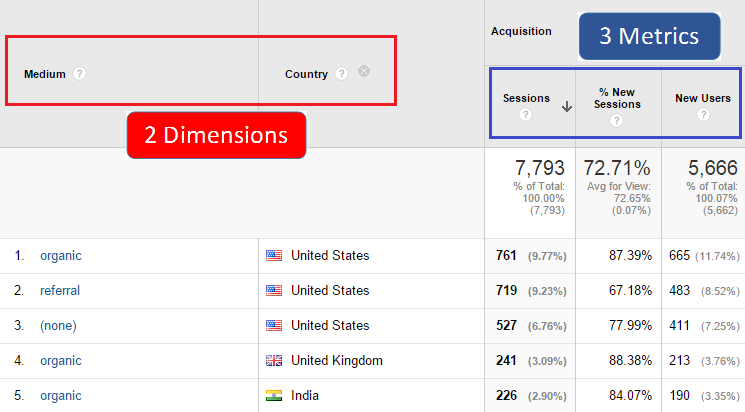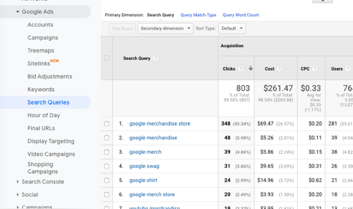What Is a "Metric" in Google Analytics? A Thorough Take A Look At Its Meaning and Significance for Information Measurement
What Is a "Metric" in Google Analytics? A Thorough Take A Look At Its Meaning and Significance for Information Measurement
Blog Article
Enhance Your Strategy Using Effective Google Analytics Metrics
In the realm of electronic advertising, the application of robust Google Analytics metrics holds the essential to unlocking important understandings that can drive your strategic ventures to brand-new heights. Comprehending the intricate details of individual behavior, conversion rates, and web traffic resources is just the tip of the iceberg when it comes to leveraging Google Analytics efficiently.
Comprehending Audience Behavior
When delving into the globe of Google Analytics metrics, among the crucial elements to realize is recognizing audience habits - what is a “metric” in google analytics. Target market actions refers to exactly how individuals interact with a web site or on the internet material. By examining this data, companies can gain valuable insights into their target routines, demographics, and choices
Google Analytics provides a riches of information on audience behavior, consisting of metrics such as the number of visitors, their geographical area, tools utilized, and the pages they go to most regularly. Understanding these metrics can help businesses tailor their advertising and marketing methods, content, and individual experience to better cater to their audience.
Tracking Conversion Rates
To successfully measure the success of internet marketing efforts and internet site efficiency, companies need to focus on tracking conversion prices. Conversion rates indicate the percent of internet site visitors that take a desired action, such as purchasing, enrolling in a newsletter, or completing a get in touch with form. By tracking these conversions, companies can evaluate the performance of their advertising and marketing campaigns, website content, and individual experience.

Furthermore, companies can utilize Google Analytics to evaluate conversion funnels, which show the steps users take in the past finishing a conversion. By determining any drop-off factors in the channel, businesses can make required modifications to improve the customer journey and increase conversion rates. Tracking conversion rates is necessary for organizations aiming to maximize their on-line performance and achieve their marketing objectives.
Studying Web Traffic Sources
One of the crucial aspects of understanding on-line performance and enhancing advertising and marketing strategies is analyzing traffic resources. By diving into where your site site visitors are originating from, you can get beneficial understandings right into the efficiency of your advertising efforts and make data-driven choices to boost your online visibility. Google Analytics provides a riches of info on the sources of your web traffic, classifying them right into networks such as natural search, direct web traffic, social networks, references, and paid search.
Assessing website traffic sources enables you to identify which channels are driving one of the most site visitors to your site, along with which ones are resulting in the greatest conversions. By identifying these patterns, you can allot your advertising budget better, concentrating on networks that bring in high-grade web traffic and changing strategies for underperforming ones (what is a “metric” in google analytics). Furthermore, understanding the sources of your traffic can assist you tailor your web content and messaging to much better reverberate with your target market throughout various channels, inevitably leading to improved interaction and conversion rates
Surveillance Web Site Performance
Google Analytics Metrics can offer indispensable insights when it concerns checking internet site efficiency. By assessing key metrics such as page tons time, bounce rate, and conversion prices, internet site owners can gain an extensive understanding of exactly how well their site is doing. Page lots time is an important metric as it directly influences individual experience and can affect bounce rates. Monitoring this metric can help determine areas for enhancement to ensure optimum site speed.
On the various other hand, conversion rates reveal how efficient the website is at transforming visitors into leads pop over to these guys or clients. By keeping track of and analyzing these metrics routinely, website owners can make data-driven decisions to enhance their website's performance and boost user experience.
Applying Custom Records
Just how can site proprietors obtain deeper understandings into their analytics data past the common reports offered by Google Analytics? By carrying out custom-made reports, services can tailor their analytics to specific requirements and goals. Customized records allow customers to concentrate on specific metrics, measurements, and sectors that are most appropriate to their service objectives. This degree of customization makes it possible for a much more comprehensive evaluation of web site performance, customer actions, and marketing approaches.
To create custom reports in Google read this post here Analytics, users can browse to the "Customization" tab and select "Personalized Reports - what is a “metric” in google analytics." From there, they can select filters, dimensions, and metrics to consist of in their records. Custom reports can vary from easy to complicated, depending upon the depth of insights needed. By making use of custom reports, website owners can reveal unique fads, patterns, and possibilities that may not be conveniently noticeable in common records.

Final Thought
Finally, leveraging powerful Google Analytics metrics can offer useful understandings right into audience behavior, conversion rates, traffic resources, web site efficiency, and custom records. By examining these crucial metrics, organizations can maximize their methods, boost user experiences, and drive much better outcomes. Constant monitoring and modifications based on data-driven choices can bring about improved on-line presence and enhanced success in attaining service objectives.
Recognizing the intricate information of customer actions, conversion prices, and traffic sources is simply the tip of the iceberg when it comes to leveraging Google Analytics efficiently.To efficiently measure the success of online advertising initiatives basics and web site efficiency, services should concentrate on tracking conversion prices.Additionally, companies can utilize Google Analytics to evaluate conversion funnels, which show the actions users take in the past finishing a conversion. By assessing key metrics such as page tons time, bounce price, and conversion rates, website owners can acquire an extensive understanding of just how well their website is performing.In conclusion, leveraging powerful Google Analytics metrics can offer beneficial insights right into target market actions, conversion rates, traffic sources, site performance, and personalized records.
Report this page